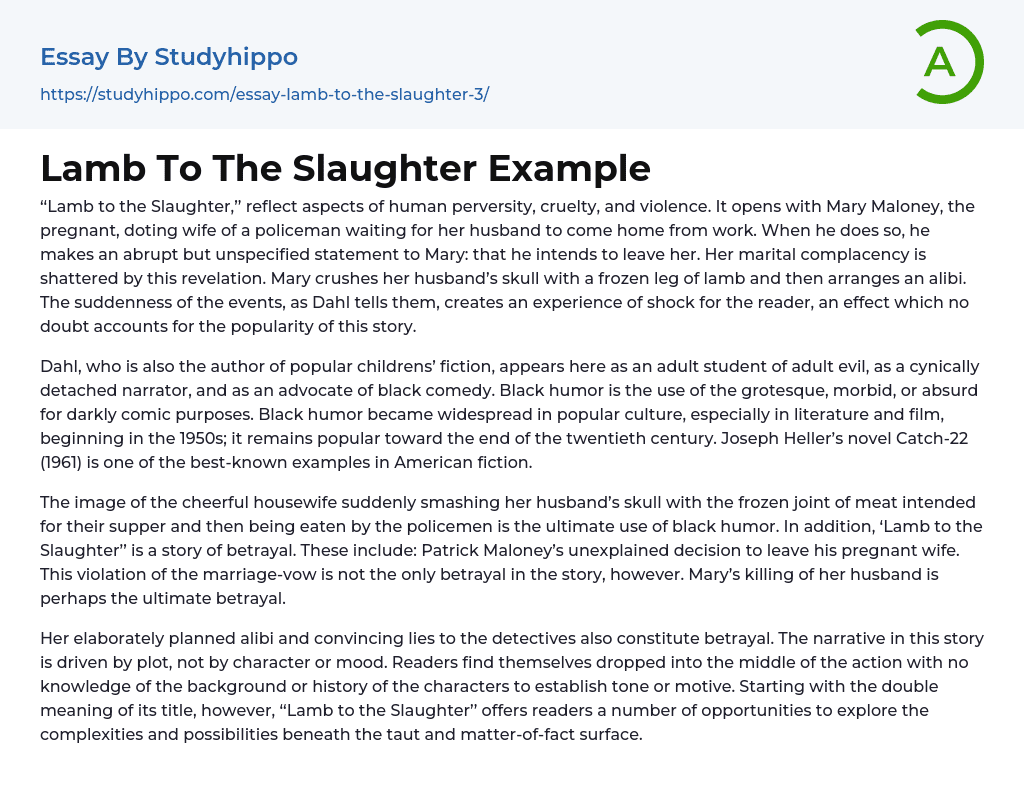The story "Lamb to the Slaughter" explores human perversity, cruelty, and violence. It begins with Mary Maloney, a devoted wife who is expecting a child, eagerly waiting for her policeman husband to return from work. However, when he does return, he delivers an unexpected and vague statement to Mary: he intends to leave her. This revelation shatters Mary's sense of security in her marriage. In a fit of emotion, she murders her husband by smashing his skull with a frozen leg of lamb and then concocts a plan to establish an alibi. The suddenness of these events, as described by Dahl, generates a shocking experience for the reader, which is likely the reason for the story's popularity.
Dahl, known for his popular childrens’ fiction, presents himself in this context as an adult student of adult wickedness, as a cynically detached narrator,
...and as a proponent of black comedy. Black comedy utilizes the grotesque, morbid, or absurd for comedic effect with a dark twist. This form of humor gained popularity in popular culture, particularly in literature and film, starting in the 1950s and has continued to be favored through the late 20th century. An exemplary instance of black humor in American fiction is Joseph Heller’s novel Catch-22 (1961).
The ultimate use of black humor is depicted in the image of a cheerful housewife unexpectedly using a frozen joint of meat, intended for their supper, to smash her husband's skull. Furthermore, "Lamb to the Slaughter" encapsulates a tale of betrayal, including Patrick Maloney's unexplained choice to abandon his pregnant wife. Nevertheless, this story is riddled with further betrayals, with Mary's act of killing her husband being seen as the
ultimate betrayal.
The betrayal in this story includes the deceiving alibi and lies told to the detectives, while the plot, not character or mood, drives the narrative. Readers are thrown into the action without any background or history of the characters, leaving them unaware of the tone or motive. Nevertheless, ‘‘Lamb to the Slaughter’’ opens up numerous chances for readers to delve into the intricate and potential meanings beneath its straightforward surface, starting from its double-edged title.
- Book Summary essays
- Metaphor essays
- Reader essays
- Rhyme essays
- Literary devices essays
- Villain essays
- Books essays
- Genre essays
- Literary Criticism essays
- Writer essays
- Protagonist essays
- Simile essays
- Poem essays
- Book Report essays
- Book Review essays
- Greek Mythology essays
- Plot essays
- Tragic Hero essays
- Coming of Age essays
- Play essays
- Rhetoric essays
- Rhetorical Question essays
- Translation essays
- Understanding essays
- Reason essays
- Character essays
- Letter essays
- American Literature essays
- Literature Review essays
- Utopia essays
- Poetry Analysis essays
- Dante's Inferno essays
- Between The World and Me essays
- Incidents in The Life of a Slave Girl essays
- Flowers for Algernon essays
- Myth essays
- Everyday Use essays
- Boo Radley essays
- Genesis essays
- Richard iii essays
- Alice in Wonderland essays
- On the road essays
- Ozymandias essays
- The Nightingale essays
- Holden Caulfield essays
- Animal Farm essays
- 1984 essays
- A Hanging essays
- Shooting An Elephant essays
- A Tale Of Two Cities essays




